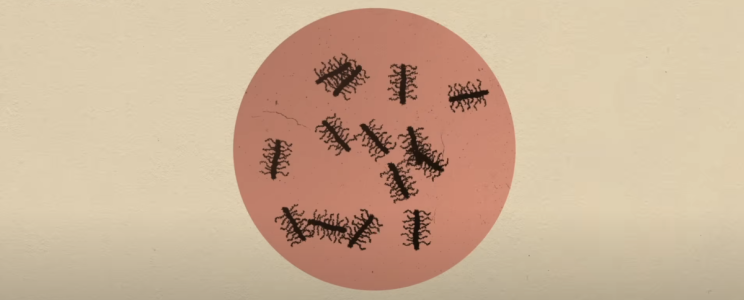Is this deadly ancient illness becoming impossible to cure? Shocking new mutation threatens millions
- Replies 0
A silent global threat is gaining strength, and most people don’t even know it’s spreading. It moves invisibly, thrives in crowded cities, and evolves faster than modern medicine can respond.
Doctors warn it has already traveled across continents and is getting harder—and in some cases, nearly impossible—to treat. Now, the world faces a high-stakes question: what happens when our last lines of defense stop working?
An Old Foe with New Tricks
Typhoid fever, caused by the bacterium Salmonella enterica serovar Typhi, has been infecting humans for centuries. It spreads through contaminated food or water and causes severe fever, abdominal pain, and sometimes deadly complications.
While it was once largely tamed with antibiotics, modern strains are beginning to resist even our strongest medicines. A sweeping global study found more than 4,000 strains now classified as extensively drug-resistant, making treatment increasingly difficult.
How Did We Get Here?
The rise of this resistance is not random—it’s the product of specific global behaviors. Overuse and misuse of antibiotics give bacteria more chances to mutate and survive.
In many regions, poor sanitation and overcrowded urban centers provide the perfect environment for rapid spread. International travel and trade allow these mutated strains to cross borders with ease, turning local outbreaks into global threats.

It’s Spreading Faster Than We Can Contain It
According to researchers, drug-resistant strains have crossed international borders nearly 200 times since 1990. Originating mostly in South Asia, they’ve now been identified in parts of Africa, Southeast Asia, and even North America and Europe.
Many of the mutations appeared independently, suggesting the bacteria are adapting quickly under pressure. Worse still, they’re developing resistance to last-line drugs, including cephalosporins and azithromycin.
Why It’s a Problem for Everyone—Not Just Overseas
Though rare in the US, this illness still affects thousands each year—mainly travelers returning from high-risk regions. But as resistance spreads, so does the risk of community-level outbreaks in places with weak sanitation.
In one case, a Massachusetts daycare temporarily shut down after a child returned from abroad with an infection. Americans who assume this disease is a “foreign problem” may be dangerously underestimating it.
What’s Making These Strains So Dangerous?
New mutations allow the bacteria to do things that make antibiotics useless. Some produce enzymes that break down the drug, while others pump it out before it can work.
The bacteria can also rewire essential survival functions, rendering once-powerful treatments ineffective. Researchers tracked nearly 100 independent mutations in a key class of antibiotics since 1990—each one making treatment harder.
The Global Response Is Falling Behind
Dr. Jason Andrews, lead author of the international study, warns that the bacteria are spreading faster than global systems can track. Many countries lack proper testing facilities or surveillance tools to monitor resistance trends.
Even where systems exist, limited sampling leaves researchers blind to how widespread the problem truly is. Without broader investment in surveillance and response, the crisis may grow unchecked.
Steps You Can Take Right Now
There are clear actions individuals can take to reduce risk and help slow resistance. First, practice good hygiene, especially before meals and after using the restroom.
If traveling, get vaccinated and avoid risky food and water. Just as importantly, avoid using antibiotics unless prescribed—and always complete the full course.
Can Innovation Buy Us Time?
Hope isn’t lost. Scientists are developing better vaccines and tools to detect resistance early.
Expanded genomic surveillance could give public health officials the data they need to act faster and smarter. But progress takes time—and the bacteria aren’t waiting.
Also read:

Have you or someone you know ever dealt with drug-resistant illness, especially while traveling? Are you concerned about how antibiotic misuse could impact you or your family? Share your story and your thoughts in the comments below. The GrayVine community is here to learn, share, and stay a step ahead together.
Doctors warn it has already traveled across continents and is getting harder—and in some cases, nearly impossible—to treat. Now, the world faces a high-stakes question: what happens when our last lines of defense stop working?
An Old Foe with New Tricks
Typhoid fever, caused by the bacterium Salmonella enterica serovar Typhi, has been infecting humans for centuries. It spreads through contaminated food or water and causes severe fever, abdominal pain, and sometimes deadly complications.
While it was once largely tamed with antibiotics, modern strains are beginning to resist even our strongest medicines. A sweeping global study found more than 4,000 strains now classified as extensively drug-resistant, making treatment increasingly difficult.
How Did We Get Here?
The rise of this resistance is not random—it’s the product of specific global behaviors. Overuse and misuse of antibiotics give bacteria more chances to mutate and survive.
In many regions, poor sanitation and overcrowded urban centers provide the perfect environment for rapid spread. International travel and trade allow these mutated strains to cross borders with ease, turning local outbreaks into global threats.

Typhoid fever, caused by the bacterium Salmonella enterica serovar Typhi, has been infecting humans for centuries. Image source: Seeker / YouTube
It’s Spreading Faster Than We Can Contain It
According to researchers, drug-resistant strains have crossed international borders nearly 200 times since 1990. Originating mostly in South Asia, they’ve now been identified in parts of Africa, Southeast Asia, and even North America and Europe.
Many of the mutations appeared independently, suggesting the bacteria are adapting quickly under pressure. Worse still, they’re developing resistance to last-line drugs, including cephalosporins and azithromycin.
Why It’s a Problem for Everyone—Not Just Overseas
Though rare in the US, this illness still affects thousands each year—mainly travelers returning from high-risk regions. But as resistance spreads, so does the risk of community-level outbreaks in places with weak sanitation.
In one case, a Massachusetts daycare temporarily shut down after a child returned from abroad with an infection. Americans who assume this disease is a “foreign problem” may be dangerously underestimating it.
What’s Making These Strains So Dangerous?
New mutations allow the bacteria to do things that make antibiotics useless. Some produce enzymes that break down the drug, while others pump it out before it can work.
The bacteria can also rewire essential survival functions, rendering once-powerful treatments ineffective. Researchers tracked nearly 100 independent mutations in a key class of antibiotics since 1990—each one making treatment harder.
The Global Response Is Falling Behind
Dr. Jason Andrews, lead author of the international study, warns that the bacteria are spreading faster than global systems can track. Many countries lack proper testing facilities or surveillance tools to monitor resistance trends.
Even where systems exist, limited sampling leaves researchers blind to how widespread the problem truly is. Without broader investment in surveillance and response, the crisis may grow unchecked.
Steps You Can Take Right Now
There are clear actions individuals can take to reduce risk and help slow resistance. First, practice good hygiene, especially before meals and after using the restroom.
If traveling, get vaccinated and avoid risky food and water. Just as importantly, avoid using antibiotics unless prescribed—and always complete the full course.
Can Innovation Buy Us Time?
Hope isn’t lost. Scientists are developing better vaccines and tools to detect resistance early.
Expanded genomic surveillance could give public health officials the data they need to act faster and smarter. But progress takes time—and the bacteria aren’t waiting.
Also read:
- Is your water safe? Shocking new toxic chemical discovery
- Hantavirus killed Gene Hackman’s wife—here’s why experts are urging caution
Key Takeaways
- A new global study found more than 4,000 strains of typhoid fever bacteria have evolved into extensively drug-resistant forms that no longer respond to most antibiotics.
- The spread of resistance is tied to overuse of antibiotics, poor sanitation, rapid urbanization, and international travel, especially from South Asia.
- While still rare in the US, cases of drug-resistant typhoid have already occurred and could become more common if global containment fails.
- Experts say poor genomic surveillance and lack of investment in detection make it difficult to track and respond to emerging drug-resistant infections.






